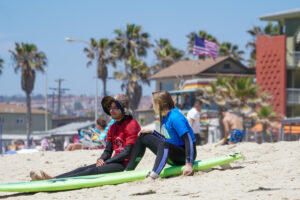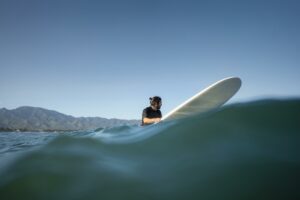Did you know that surfing was added to the Olympics in 2020? This shows you how popular surfing is becoming as a worldwide sport. There are 2.874 million surfers in the United States alone and an estimated 35 million worldwide.
Are you fascinated by the ocean and the surf and interested in conquering it by surfing? If you are new to the sport, you will want to find the perfect surfboard size for you. This will ensure you learn the sport properly and don’t wipe out too often.
In this article below, we will give you the lowdown on how you can get the right size surfboard by doing some accurate calculations.
Beginner Surfboard Size – Bigger Is Always Better
If you are a beginner surfer, your surfing instructor will always recommend you get a longer and thicker board. This is because the first thing you need to learn is buoyancy and stability. Of course, as you get better at surfing, what you need from a surfboard will change.
Some people suggest that beginners pick a surfboard that’s 3 feet longer than their height.
If you are an intermediate surfer, you would choose a surfboard that’s one palm higher than your height. You can see that’s quite a range!
Most beginner surfers will choose a longboard to start. That’s what everyone begins with, and it’s a great size to learn on.
As you get better at surfing, you will notice that a longboard will become cumbersome and hold you back from doing all that you want on a surfboard.
Pay attention to this. Everyone learns surfing at a different rate, so you will want to watch out for when you outgrow your longboard.
Speak to your surfing school to figure out which surfboard would be good for you as you progress.
Choose an Above Average Paddling/Flotation Ratio
When you are a beginner surfer, you will want to choose a surfing board with an ABOVE average padding/flotation ratio. What does this mean?
The higher the paddling/flotation ratio, the more stable your surfboard is on the waves. This is great for a beginner surfer because it will help you get in the waves faster and make it easier for you to paddle while on the board.
It will also make it easier on you and be more forgiving when the pop-up moment arrives. This can help you stand up faster, which is the whole point after all.
You will never become a better surfer if you spend all your time paddling on your surfboard but are never able to stand up. Don’t be ashamed to start with an easier board.
Every beginner has to start somewhere. Once you become comfortable with standing up on your surfboard, you can move to a more intermediate surfboard.
Polyurethane or Algae – Surfboard Material
As surfing becomes more ubiquitous, surfboard technology is also advancing rapidly. Even so, most surfboard cores are made up of polyurethane, which has a dire environmental impact.
Thankfully, many surfboard manufacturers are moving towards using algae or epoxy for the surfboard core, which are more environmentally friendly options.
If you are renting a surfboard from your school at first, to see if you even like surfing, then you can go along with whatever they have in store. But when you are thinking about purchasing your surfboard, think about getting something that is made of more sustainable material.
Which Surfboard Shape to Choose as a Beginner?
Surfboard designers spend hundreds of hours testing out different surfboard shapes and designs to find the one that performs the best in the water. They also choose shapes that impact resistance to the water. Board weight and design are chosen and worked upon carefully as well.
That’s why you will want to pay attention to this as a beginner surfer. A few shapes to keep in mind are:
- Rounder template – gives you a more laid-back surf, allows greater buoyancy, and more planning lift potential
- Wider boards – more flotation and great for small, mushy waves
- More rocker – harder to paddle, but less nosediving
- Pin tail – great for all-round surf conditions
- Round tail – great for all-round surf conditions
- Squash tail – great for all-round surf conditions
- Rounded tail – great for all-round surf conditions
If all these phrases and terms are causing your eyes to go buggy-eyed, then don’t worry. The best thing to do is to have an in-depth conversation with your surfing school or instructor, and they will be able to give you recommendations on the best surfboard for you.
The Best Surfboard Size for You Is the One You Enjoy Riding the Most
The most important truth with surfboard sizes is that there are a wide variety of surfboard types out there. And all of them are suitable for an even wider variety of surfing conditions, waves, and riding styles. They also have a wide variety of impacts on surfing performance.
That’s why when you are just starting; it’s quite important to try out a bunch of different surfboards to see what you like. You might be surprised to find out that the surfboard your instructor recommended to you doesn’t work for you, but something quite different does!
Find a surfboard size that you enjoy riding, and that’s the essential truth of the matter here.
Stop Asking: What Size Surfboard Do I Need?
With all these criteria in mind, you are on your way to choosing the best surfboard size for you as a beginner.
If you are interested in renting a surfboard or taking surfboard lessons in San Diego, then Pacific Surf is waiting to serve you. No matter what your surfing level, we want to help you learn surfing and give you those amazing memories that you will treasure forever. We also have surf camps for children and teens.
Learn more about our private surf lessons here.




